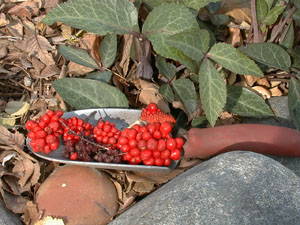Home > Education > Plant Profiles > Featured Plants: Summer Bulbs
William's Featured Plants - Summer Bulbs - Spathe & Spadix
The flower structure of the Araceae or arum family is a spathe and spadix. Individual flowers are usually found at the base of the spadix, which is covered by the spathe. The tip of the spadix normally protrudes out from the spathe. The swollen tip is able to chemically generate heat through a process called thermogenesis.
Few plants outside of the arum family have the ability to create their own heat. In some genera the temperature around the spadix can be twenty degrees higher than the ambient air temperature. The hardy skunk cabbage, Symplocarpus foetidus , often melts snow and ice as it rises in American woods in February. More typically the arum family uses this heat to better disperse their unique fragrances throughout their location.
Many of the spathes are dull colored and hidden by foliage. Creating strong scents helps insects locate the flowers. Since lots of Araceae pollinators are fungus gnats, carrion beetles, and the like, the family has devised some of the most potently foul smells to attract them. Common names for some genera include devil's dung and corpse plant.
Once the bugs and beetles arrive the plants will often use hairs, constricted areas, and false "windows" to keep them trapped near the lower part of the spadix with the female flowers. After a short period the female flowers become unreceptive, next the male flowers shed pollen all over the insects, and then they are allowed to leave the spathe to go pollinate another flower.
If pollination is successful, the female flowers at the base of the spadix begin to swell. After a while a stalk of berries is produced. In many species the fruits are bright red or orange. These berries add color and interest to the shady garden while supplying food to foraging birds.

More info on summer bulbs
Families of summer: Amaryllids and Aroids
Amaryllid Flowers |